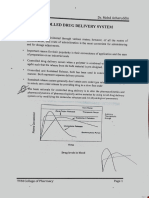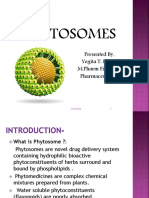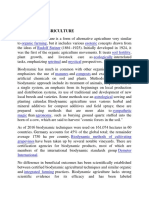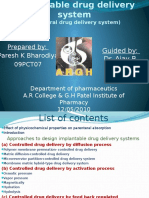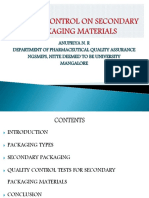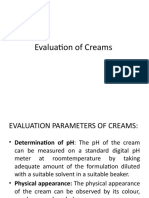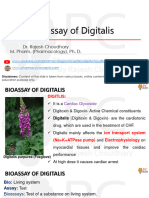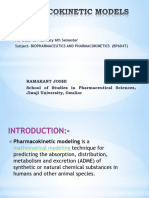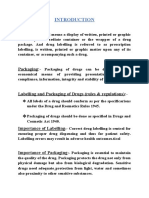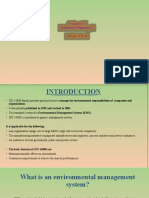0 ratings0% found this document useful (0 votes) 763 views6 pagesIntroduction To Platform Technology
Copyright
© © All Rights Reserved
We take content rights seriously. If you suspect this is your content,
claim it here.
Available Formats
Download as PDF or read online on Scribd
Introduction to Platform
Technology & its Benefits in
Pharmacy
« Platform technology refers to a
standardized method, process, or system
that can be applied across various
applications in drug development and
manufacturing.
¢ Byusing a consistent approach or set of
tools, pharmaceutical companies can
streamline R&D efforts, reduce costs,
enhance consistency, and accelerate
product development.
Introduction tPaterm Teehrlogy
tranny \S
aime cave
Here's a mind map on "Introduction to Platform
Technology in Industrial Pharmacy":
© scanned with OKEN Scanner�Commonly Used Platform
Technologies in Pharmacy:
1. Biologic Production Systems:
¢ Monoclonal Antibodies (mAbs): These
are proteins designed to target specific
components of the body, and they
require specific cell lines for production.
Once the production process is
optimized for one mAb, it can be applied
to others with minor modifications.
¢ Recombinant Protein Production: Using
bacterial, yeast, or mammalian cell
cultures to produce therapeutic proteins
is a platform that can be adapted for
different proteins.
2. Drug Delivery Systems:
¢ Liposomal Systems: Liposomes,
spherical vesicles with at least one lipid
bilayer, can encapsulate drugs to
improve delivery, solubility, or
biodistribution. Once a specific
liposomal system is designed, it can be
applied to various drugs.
¢ Nano-emulsions and Micelles: Used to
improve drug solubility and enhance
absorption.
© scanned with OKEN Scanner�3. Gene and Cell Therapy
Platforms:
* Viral Vectors: Adenoviruses, lentiviruses,
and adeno-associated viruses are
commonly used vectors for gene
therapy. Once the vector's delivery
method is established, it can be loaded
with various therapeutic genes.
¢ CAR-T Cell Therapies: A method where a
patient's T-cells are modified to attack
cancer cells and then re-infused into the
patient.
4. mRNA Platforms:
¢ As popularized by the COVID-19 vaccines
from Pfizer-BioNTech and Moderna, this
platform uses messenger RNA (mRNA)
to instruct cells to produce a protein that
triggers an immune response. The base
technology can be adjusted for different
diseases.
(HTS):
« Automated systems that allow rapid
testing of thousands of compounds to
identify potential drug candidates.
© scanned with OKEN Scanner�6. Continuous Manufacturing_
Platforms:
¢ Instead of batch-wise production,
continuous manufacturing processes
drugs without interruption, enhancing
efficiency and consistency.
7. 3D Printing of Drugs:
e This technology allows for the
customization of drug dosage forms,
especially for personalized medicine
approaches.
8. Nanotechnology Platforms:
e Nanoparticles, dendrimers, and quantum
dots have been explored for their
potential in targeted drug delivery and
diagnostics.
© scanned with OKEN Scanner�Benefits in Pharmacy
1. Accelerated Development:
¢ With an established platform, the drug
development process can be expedited,
reducing the time from concept to clinic.
2. Cost Reduction:
* The investments in developing and
validating the platform can be spread
across multiple products, leading to
potential cost savings in the long run.
3. Enhanced Consistency and Quality:
* Using a standardized approach can lead
to greater consistency in product quality.
4. Scalability:
* Once the platform technology is
optimized, it is often easier to scale up
for mass production.
5. Regulatory Familiarity:
* As regulatory agencies become
acquainted with a particular platform,
subsequent regulatory approvals for
products using the same platform might
be streamlined.
© scanned with OKEN Scanner�< Aset of shared, standardized methods and processes,
n
Enables rapid development of new products
‘Speeds up product development
Reduces costs,
Benefits
Ensures consistent qualily
Facilitates regulatory approval
Liposomal drug delivery
Nanoparticle systems
Common Platforms in Industrial Pharmacy
Controlled release technologies
Introduction to Platform Technology
(Industrial Pharmacy)
Monoclonal antibody production
Initial investment in technology
-~
Implementation Challenges Training and expertise requirements
Integration with existing systems
Ensuring platform compliance
Streamlined approval for products using validated
Regulatory Considerations ata
Continuous monitoring and validation
Adaptability to emerging therapies
Future Potential Role in personalized medicine
Potential for automation and Al integration
® scanned with OKEN Scanner


